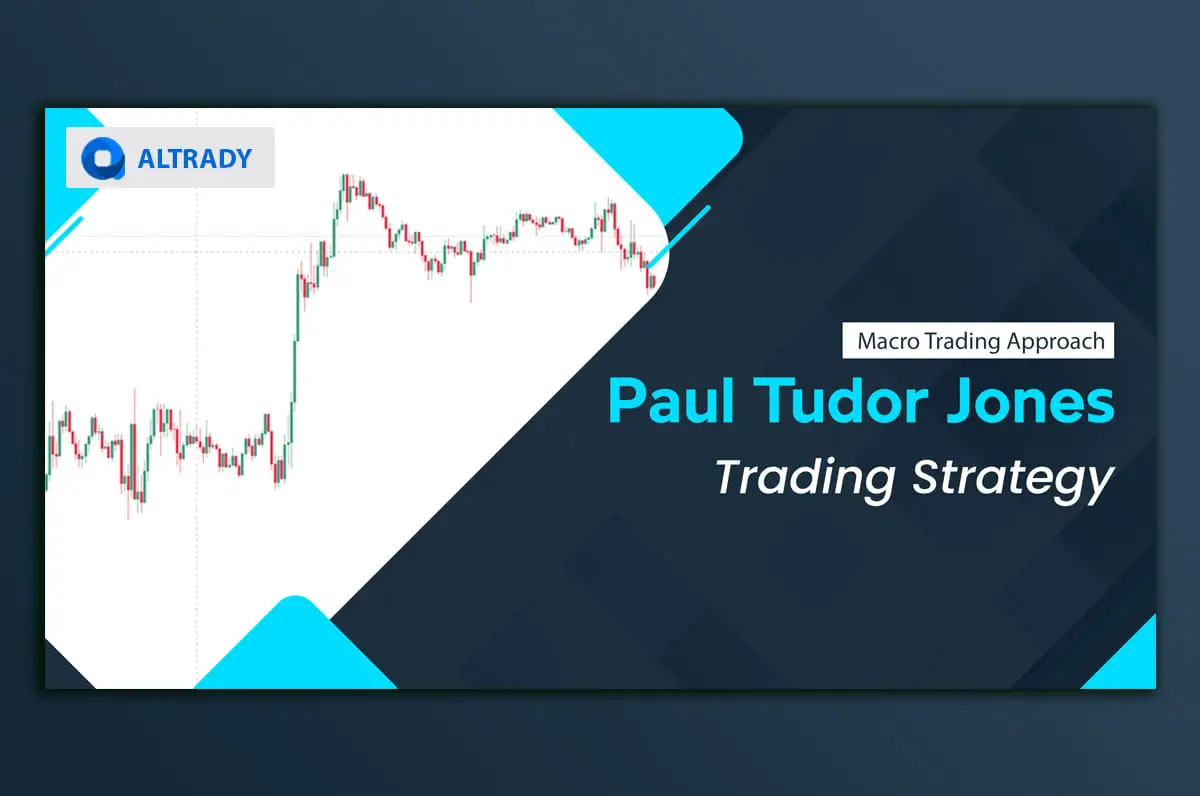Category List


Paul Tudor Jones Trading Strategy | Macro Trading Approach
With an undisputed record of long-term average annual returns of around 19.5%, while maintaining a winning streak without a single loss for 25 consecutive years until 2014, Paul Tudor Jones’ macro trading method has left valuable lessons for approaching all markets, including the cryptocurrency market.
At Altrady, we've studied and adapted the strategies of legendary traders like Paul Tudor Jones for the unique dynamics of the cryptocurrency market. This article explores his macro trading approach and how it can be applied to crypto.
You will learn about his method, and how it relates to crypto. You can test it in paper trading later to check the power behind the single indicator he used which was a moving average.
The PTJ's Method
Paul Tudor Jones' trading procedure is one of the most outstanding methodologies involved in the financial markets as it uses a strategy that seems, first and foremost, counterintuitive. However, it represents an advanced technique that seizes an edge out of reversal movements while keeping a trend-following implementation over those reversals.
To achieve such an ambitious goal, PTJ discovered the reliability of the 200-day moving average on closing prices and developed a mid-term to long-term only method, establishing the basis for what would be more than a swing trading strategy, but a fully integrated macro trading approach and profitable like no other.
Turning Points: The Key To Paul Tudor Jones' Success
Typically, traders strive to place positions in the momentum beginning and manage those trades in the middle of a trend, sticking to the prevailing direction.
However, for PTJ, that does not represent a real advantage ahead of the market as a turning point does. In this sense, his trading is based on reversal momentums.
Specifically, he crafted a ruled system for entries and exits such as follows:
- Entering long positions when the price breaks above the 200-day MA while exiting all short positions.
- Opening short positions when the price breaks below the 200-day MA while closing all long positions.
Altrady's integration with Tradingview makes it easy to add and customize the 200-day moving average. |
The Macro Trading Analysis Framework: 200 Moving Average
Macro trading could mean various things for different traders and analysts. For Paul Tudor Jones, it means assembling a broader approach ahead of the rest of the market participants, recognizing risk management as the most crucial aspect of a trading system to cut losses rapidly, but leaving room for a versatile execution and conduction of analysis from a technical and fundamental perspective.
"I love trading macro. If trading is like chess, then macro is like three-dimensional chess".
We should not consider PTJ a technical or fundamentalist trader but rather a risk
management trader; this was the key to his success. He experienced several losses in his early 20s that taught him valuable lessons on the subject of risk.
His performance is clear and truthful proof of such a mindset, as he operated, as mentioned earlier in this article, counter-intuitively to what most traders repeatedly spread about trending markets.
"When it comes to trading macro, you cannot rely solely on fundamentals; you have to be a tape reader, which is something of a lost art form."
The PTJ notion for trend trading was not simply to look for primary momentum but reversal momentum based on the breakout of some level. He detected such a level breakout according to the 200-day moving average.
In this sense, he is often referred to as a top and bottom trader since tops and bottoms are levels at which the reversal price action begins. However, if we go deeper and study, for example, the case of Black Monday in 1987, we realize that his technique goes beyond tops and bottoms.
"The inability to read a tape and spot trends is also why so many in the relative value space who rely solely on fundamentals have been annihilated in the past decade. Markets have consistently experienced '100-year events' every five years…
While I spend a significant amount of my time on analytics and collecting fundamental information, at the end of the day, I am a slave to the tape and proud of it."
We have addressed the 200 MA utility before and understand why it works. We can now conclude that this approach provided PTJ with valuable simplicity from a technical standpoint and, at the same time, generated a reliable signal for a trade.
"When I think of long/short business, to me there’s 5 ways to make money: 2 of those are you either play mean reversion, which is what a lot of long/short strategies do, or you can play momentum/trend, and that’s typically what I do."
Applying PTJ’s 200 Moving Average to Crypto
In the following examples, we are going to discuss how the 200-period moving average works in crypto trading and its correlation to Paul Tudor Jones’ macro analysis method.
The image below shows three scenarios:
- Bitcoin breaks above the 200 MA and starts a sustained uptrend.
- Bitcoin breaks below the 200 MA and starts a sustained downtrend.
- Bitcoin breaks below but then pulls back before starting a sustained move, leaving a failed breakout.

Let’s study every situation.
Breaking Above
In this case, the price of BTC breaks above and performs an upside move towards a peak price of $109000, establishing a new ATH (all time high).
Regarding the fundamentals behind this movement, we can point out as a principal factor the hype generated by Trump’s inauguration as president of the US. In fact, the ATH was made during the day of the inauguration.

Breaking Below
Days after the inauguration, the Trump’s administration announced a 25% increase in tariffs on China, Canada, and Mexico. This news has not been well received by the global markets, including BTC, a situation that has brought down the price of BTC since then.
Additionally, the reports on US inflation and the comments by Fed chairman Jerome Powell on a pause in interest rate cuts added weight to the bearish sentiment of the market.

Handling a Failed Breakout: Volatility Implications and Risk Management
Amid Trump's announcements and subsequent setbacks after meeting with the governments of each country involved in the tariff package, the market sank into a period of uncertainty that led to a drop in prices and an almost immediate recovery days later to the same previous levels.

Such a situation reflects the volatile characteristic of the crypto market, a condition that requires employing risk management methods specifically adapted to cryptocurrencies. For example, while implementing a macro trading approach, also consider the following:
- Staying informed with the latest news about global markets and crypto specific events.
- Adjusting position sizes and stop-loss targets according to the expected volatility potentially generated by fundamental factors as demonstrated above.
Altrady's position size calculator helps you determine the appropriate position size based on your risk tolerance |
Risk Management: 5:1 Risk-Reward And Minimum Drawdown
This macro trading, backed up by a simple technical and fundamental strategy for long-term goals, was empowered by an exceptional five-to-one risk-reward plan: it implies a positive asymmetry where the potential profits are five times what a trader risks per position.
"I consider myself a premier market opportunist. That means I develop an idea on the market and pursue it from a very low-risk standpoint until I have repeatedly been proven wrong, or until I change my viewpoint."
Along with that 5:1 objective for gains, PTJ also recognizes the intrinsic ability of every individual to successfully hit that goal:
- Traders must be able to emotionally detach from their trading to get a wrong trade out from their committed capital and do so quickly.
- But instead, hold onto a winning position longer.
"I try to avoid any emotional attachment to a market. I avoid letting my trading opinions be influenced by comments I may have made on the record about a market."
The 1987's Black Monday Case: 200% Returns
The Black Monday market crash event of 1987 that led to the largest stock market decline in history was preceded by a situation commonly referred to as an irrational market.
There were technical signals and fundamental reasons that a macro trader like Paul Tudor Jones could spot, like overleveraging conditions incentivized by extremely greedy investors alongside correlations to a crash in the past.
We can point out the following results:
- The Dow Jones Industrial Average (DJIA) fell by 22.6%
- PTJ made an estimated 100 million dollars, tripling his company's capital.
To illustrate the reasons behind the crash, let's use the following table:
| Fundamental | Technical |
|---|---|
|
|
|
|
|
|
Macro Trading in Crypto: Bitcoin, And What Can We Learn To Adapt PTJ’s method to Crypto
PTJ is a Bitcoin enthusiast and he bought it in 2020. Regarding the 87's crash and the macro trading approach, crypto traders have valuable lessons to learn:
- Bitcoin and crypto markets are also affected by fundamental and technical factors.
- Spot ETF approval in the US was a fundamental cause for the latest bull run of 2024 towards a new ATH of $73000.
- The Halving is a technical event that influences the market cycle of BTC by reducing supply.
- Trump’s election victory and positive promises about the crypto industry sparked a new rally that led BTC towards a new all time high around $109000.
Conclusion
Paul Tudor Jones' Macro Trading is a method that integrates all the factors that affect the price of an asset, where the most vital technique is risk management as the key to a 5:1 risk reward along with simple execution through a single indicator like the 200 MA
Through features like the Market Explorer and a technical terminal, Altrady offers a perfect crypto trading platform for a macro approach. Start a free trial account today.
In this post
- The PTJ's Method
- Turning Points: The Key To Paul Tudor Jones' Success
- The Macro Trading Analysis Framework: 200 Moving Average
- Applying PTJ’s 200 Moving Average to Crypto
- Risk Management: 5:1 Risk-Reward And Minimum Drawdown
- The 1987's Black Monday Case: 200% Returns
- Macro Trading in Crypto: Bitcoin, And What Can We Learn To Adapt PTJ’s method to Crypto
- Conclusion





























